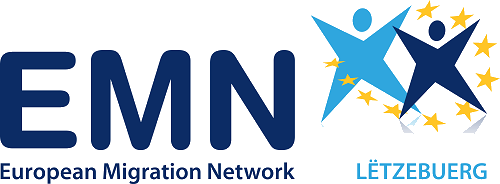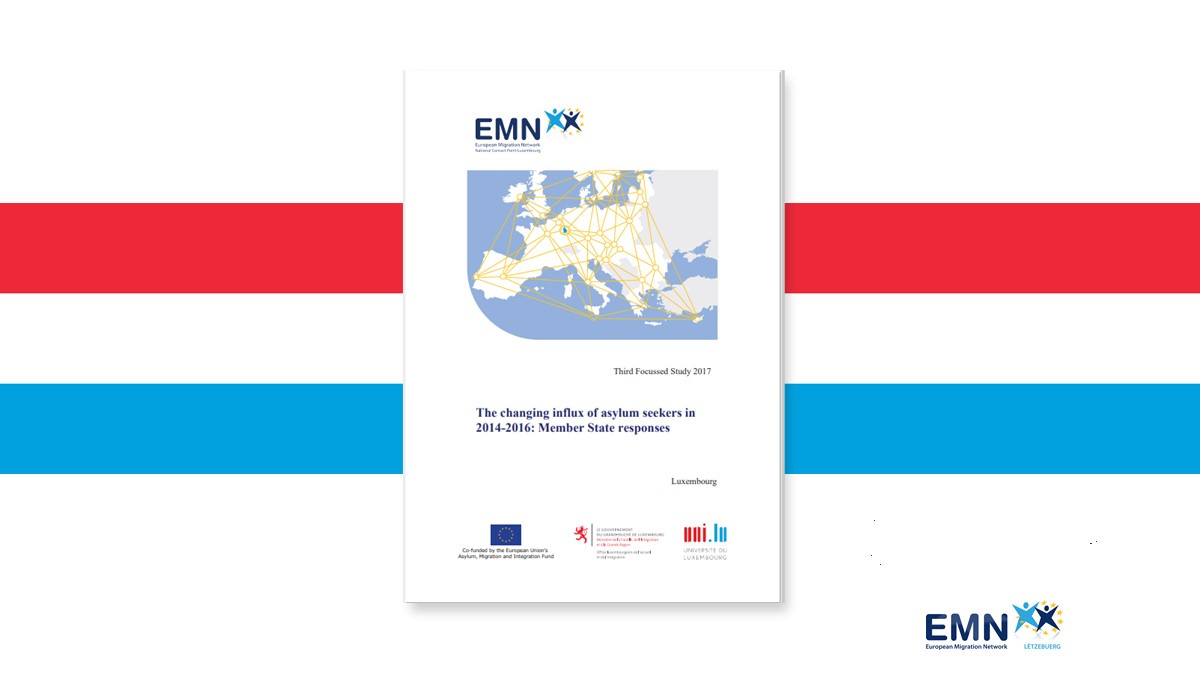The present report summarises the main findings of the LU Study on “The changing influx of asylum seekers in 2014-2016”.
| Applications for international protection significantly increased in Luxembourg from August 2015 onwards, the total number of applications in fact more than doubling when compared to the previous year (2.447 applicants in 2015; 1.091 in 2014). The number of applications remained high in 2016 (2.035 applications) and 2017 (2.322 applications) albeit slightly decreasing when compared to 2015.
These figures are not unprecedented. The number of applications introduced in Luxembourg have fluctuated since 1999, the peaks and declines correlating with specific events. Luxembourg received 2.920 applications for international protection in 1999, an effect of the conflict in Kosovo. Later, the country saw two more peaks in applications after the turn of the century (2003 and 2004 with 1.550 and 1.577 applications respectively, 2011 and 2012 with 2.171 and 2.057 applications respectively). On the other hand, 2005 to 2010 can be characterised as a period of relative calm. The current period of higher arrivals of applicants for international protection is characterised by a change in cultural profile. Previously, most of the time, a majority of people applying for international protection in Luxembourg stemmed from European countries. The influx of applicants in 2015 and 2016 was characterised by the arrival of people stemming from Arabic-speaking countries, populations which had been relatively small in Luxembourg up to that point. While not necessarily unprecedented in magnitude, high numbers of monthly arrivals, especially in the last months of 2015, put those in charge of registering applications as well as of housing and providing social follow-up to the test and led to a number of measures being taken. Generally speaking, from the beginning of the increased arrivals in Luxembourg in 2015, the government adopted a relatively open and welcoming position. This position is illustrated for instance in the government’s stance in favour of a solution for the reception of applicants for international protection that is based on European solidarity and the government’s investment in relocation and resettlement.[i] The openness is also visible in the elaboration of an emergency plan for the reception of applicants of international protection, the mandate for which was given to the High Commission of National Protection by the Council of Government on 24 July 2015. A concept for a first and second phase of the plan was approved by the Council of Government on 11 September 2015. The first phase consisted of the establishment of primary reception centre at the end of 2015, installed in repurposed existing structures. In the medium-term, the plan foresaw the establishment of modular housing structures from mid-2016 onwards. While OLAI managed approximately 60 housing structures with about 2000 beds before the influx in 2015, this number grew to 93 structures with 4.308 beds by the end of 2016. In order to respond to the increased need for services provided by OLAI, the agency’s human resources capacity was strengthened. Mainly in the domain of social services and housing, social workers, educators and housing structure managers were hired. Civil servants and employees were sent by other administrations and ministries for temporary support. OLAI’s technical service, responsible for the logistics and maintenance of housing structures, was also reinforced in order to guarantee the opening and further planning of housing structures. Part of the social follow-up of the applicants for international protection residing in a number of the reception facilities was delegated to non-governmental organisations (NGOs), for instance to the Red Cross, Caritas and the Immigrated Workers’ Support Association (Association de Soutien aux Travailleurs Immigrés – ASTI). The external partners increased their staff in relation to the demand for management of housing structures and social follow-up of the residents. The social service of the OLAI remained in charge of giving material and financial help. OLAI also increased the use of external service providers for guarding services. he government introduced amendments to the bill on the reception of applicants for international protection and temporary protection of 29 September 2015, following the rise in applications observed in 2015 and explicitly noting the changed international context. A number of the newly introduced elements, more generous than those included in the original bill were, were later removed in the finalised law by the legislator. The government introduced amendments to the bill on the reception of applicants for international protection and temporary protection of 29 September 2015, following the rise in applications observed in 2015 and explicitly noting the changed international context. Following criticism / opposition from the Council of State, the evolving situation with regard to influx of refugees during the year 2015 and in view of the time pressure for transposing the re-cast directive before the end of the year, several provisions that had been introduced by the initial bill were excluded (i.e. the possibility for applicants to participate in a “support project” after a certain period following their application as well as a progressive increase of their monthly allowance). More generally speaking, many administrations strengthened their staff over the considered period of time. OLAI increased the personnel in many of its services, most significantly its Social Service and Housing Service. The Directorate of Immigration recruited 15 additional officers between October 2015 and June 2016. The Ministry of National Education, Childhood and Youth recruited additional teachers and intercultural mediators, while the Service for Schooling of Foreign Children was also strengthened. The Directorate of Immigration undertook a number of organisational changes within the Asylum Unit, in order to accelerate the procedure, to optimise the unit’s functioning and adapt it to the changed profile of applicants. Geographical sections for interviewers and decision-makers, a ‘Task Force Afghanistan Iraq’ and a section responsible for all COI-related work were created. The Ministry of National Education, Childhood and Youth established a ‘Refugee Task Force’ coordinating its different initiatives for child and adult applicants for international protection. Luxembourg’s system for school and vocational training was further adapted to take into account the increasingly heterogeneous population of its pupils, this however not being solely due to the increased influx, but inscribing itself in a wider strategy of school diversification. In adult education, the offer for language courses increased. OLAI’s Directorate received more contact requests as a result of the increased arrival of applicants for international protection. OLAI established a communication strategy to better respond to the increased need for information from the media, the municipalities and the general public and provided amongst others, more information to municipalities through meetings and brochures. The influx of applicants for international protection also precipitated measures targeted at beneficiaries of international protection being taken. These include the establishment of the Luxembourg Centre for Social Cohesion and Integration, part of the Red Cross and supported by convention to the Ministry for Family and Integration. The centre, which opened its doors in April 2016, takes care of the integration of beneficiaries of international protection into Luxembourg’s society, putting its emphasis on facilitating access to housing. The government also launched a package of measures, aimed at municipalities, facilitating reception and integration of beneficiaries of international protection. Over the considered period, OLAI, in cooperation with the Ministry of Equal Opportunities and the Ministry of National Education also launched two pilot projects. The first was entitled “Welcome to Luxembourg: Women and Men” focussed on integration of applicants for international protection, with particular focus on equal opportunities between men and women. The second considered how to best include beneficiaries of international protection into OLAI’s ‘Welcome and Integration Contract’. This led to the Government Council’s decision to set up the Guided Integration Trail (PIA- Parcours d’intégration accompagné) on 8 March 2017. As more applicants for international protection arrived in Luxembourg, a surge of material donations was registered and more members of the wider public contacted OLAI and associations to enquire on possibilities of volunteering. To respond to these trends, OLAI established the ‘Hotline Bénévolat’, a one-stop information centre on volunteering in Luxembourg. Two temporary collection centres for material donations were also created by OLAI, later replaced by a permanent collection and sorting centre run by Spëndchen asbl. As Luxembourg’s general public became aware of the increase in applicants for international protection entering into Europe and Luxembourg in 2015, many volunteer support initiatives were formed, civil society manifesting great commitment in the reception of and care for the people arriving in Luxembourg. This solidarity was also visible in the financial support granted to projects in the context of the programme mateneen of the Oeuvre Nationale de Secours Grande-Duchesse Charlotte. It should be noted that these initiatives fall outside of the scope of the study, being driven by non-state actors. After the considered period (2014-2016), a number of important additional measures were taken to respond to new challenges set by the influx. The question of definitive integration became more pertinent as the recognition rate of applicants for international protection rose significantly. OLAI, in collaboration with the Ministry of National Education, Childhood and Youth elaborated the ‘guided integration trail’, a multidisciplinary package of measures that aims to empower AIPs and BIPs, and support them in becoming more independent and in developing their life project. The trail focus is language learning and civics courses. Aiming to facilitate the integration of beneficiaries of international protection into Luxembourg’s labour market, Luxembourg’s National Employment Agency set up a “cellule BPI” (Beneficiary of international protection cell) in its Employer Service. This cell provides employers with information regarding hiring beneficiaries of international protection and facilitates evaluations of their competences. As an answer to the resurgence of an increased influx of applicants for international protection from the Western Balkans in early 2017, a new ‘ultra-accelerated’ procedure was put in place for applicants for international protection stemming from the Western Balkans. As a response to the phenomenon of Luxembourg experiencing an increase in arrivals of individuals already having introduced an application for international protection elsewhere, and the increase in decisions of incompetence and of transfer to other Member States, a ‘semi-open return structure’ was put in place in Kirchberg in April 2017. This structure is intended for persons to be transferred to states applying the Dublin regulation. |
Overall, administrations agreed that the increased communication between ministries, administrations and non-state actors constitutes a fundamental difference with previous influxes. Ministers were provided with an update on the works linked to the mass influx in a vast majority of the meetings of the Council of Government that took place between 11 September 2015 and 6 July 2016. In the context of the emergency plan, a number of groups were set up to coordinate its implementation and to disseminate information, bringing together a wide variety of representatives of ministries, administrations and non-state entities. In addition, ministries exchanged information bilaterally during topical meetings, regularly met with the associations managing return structures and set up internal working groups. Interviewed local administrations also greatly increased coordination with local actors and established working groups on specific topics.
[i] See for instance: Official Site of the Presidency of the Council of the European Union, Grand Duchy of Luxembourg, En visite à Athènes, Jean Asselborn a assisté au départ de 30 demandeurs d’asile qui vont être relocalisés au Luxembourg (4.11.2015), in: eu2015.lu, URL : http://www.eu2015lu.eu/fr/actualites/articles-actualite/2015/11/04-asselborn-athenes/index.html
You may also want to read our latest related publications:
- Synthesis Report – Changing Influx of Asylum Seekers 2014-2016
- EMN Flash – How did member states react to the fluctuations of the influx of asylum seekers?
- EMN Inform – Changing influx of asylum seekers 2014-2016
Available here.

